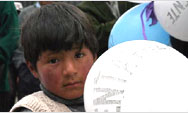HIV/AIDS: Microbicides
Under the United States President’s Emergency Plan for AIDS Relief, USAID supports the research and development of microbicides to prevent transmission of HIV.
Global Interest in Microbicides
 |
| At the Population Council-sponsored Epilisweni Center for Wellness Studies in Gugulethu, South Africa, managed by the University of Cape Town, staff are trained on protocol implementation and good clinical practice for a large-scale efficacy trial of the candidate microbicide Carraguard. Source: Stephanie Skoler |
In 2005, UNAIDS estimated that 17.5 million women and girls were infected with HIV, accounting for nearly 50 percent of infections worldwide. In sub-Saharan Africa, almost 60 percent of infected individuals are women. Despite their great risk, many women find it difficult to protect themselves from HIV infection through negotiating delay of sexual debut, partner reduction and condom use. A need therefore exists for HIV prevention methods that women could use without their partner’s participation. As an agency committed to international development and a key partner in the President’s Emergency Plan for AIDS Relief, USAID supports the development of microbicides (products that could be applied vaginally to prevent sexual transmission of HIV) as one of several methods to address this urgent and yet unmet need for protecting women in developing countries against HIV/AIDS.
Leadership in Microbicide Research and Development
For more than a decade, USAID has been a global leader in microbicide research and development. Since 2000, USAID has collaborated with the National Institutes of Health (NIH), the Centers for Disease Control and Prevention (CDC), and the Food and Drug Administration to develop and implement the U.S. Government Strategic Plan for Microbicides. Guided by this plan, USAID is committed to supporting the development of safe, effective, acceptable, and affordable microbicide products that are suitable for use in developing-country public sector programs. USAID contributes significantly to the following objectives of the Strategic Plan:
- Preclinical development and evaluation — Supporting the discovery, development, and preclinical evaluation of microbicides through investment in the early stages of research
- Formulation and delivery — Developing and assessing safe and acceptable microbicide formulations and modes of delivery
- Clinical trials — Conducting clinical studies of potential microbicides to assess safety, effectiveness, and acceptability in reducing the transmission of HIV and other sexually transmitted infections
- Behavioral and social science — Supporting behavioral and social science research to enhance microbicide development and identify social, cultural, and other factors that might undermine use and continued use
- Training and infrastructure — Building sustainable institutional capacity, training investigators to conduct international research, and accelerating access to microbicides in developing countries
USAID’s staff members have expertise in reproductive health, virology, product development, clinical trial design, social science research, pharmaceutical regulatory affairs, ethics, community involvement, gender issues, and international development. This enables USAID to provide technical leadership and strategic advice in collaboration with its implementing partners and other relevant stakeholders in order to achieve the objectives set by the President’s Emergency Plan for AIDS Relief.
At a glance...
USAID’s contribution to microbicide research and development:
- $40 million in funding in 2007
- $96 million in funding from 2001 to 2006
- Support for large-scale clinical trials
- Expertise in reproductive health, virology, product development, clinical trial design, social and behavioral science, regulatory affairs, ethics, community involvement, gender issues, and international development
Current Activities
 |
| An applicator used to deliver 4 ml of Carraguard gel in the Population Council's large-scale effectiveness trial in South Africa. The bar code facilitates accountability and study management at the clinics. Source: Karen Tweed-Holmes/Population Council |
In 2007, USAID’s financial support for microbicide research and development has grown to $40 million, representing a dramatic increase from an initial $12 million in 2001 and bringing the total amount of funding since the program’s inception to more than $175 million.
It has not yet been demonstrated that any microbicide can prevent HIV transmission. Therefore, the top priority of USAID is to support large-scale clinical trials of candidate microbicides to test whether they are safe and effective enough for women to use easily to reduce their risk of acquiring HIV. Approximately 75 percent of the current USAID annual funding supports these large-scale trials of potential microbicides. The remaining USAID funds support research on next-generation microbicide leads and clinical trial site development, as well as relevant social science and policy development.
Partners for Success
USAID collaborates with CDC and the World Health Organization. The Agency also works with the CONRAD Program, Family Health International, the Global Campaign for Microbicides, the International Partnership for Microbicides, PATH, and the Population Council, among others. USAID provides technical collaboration and funding to all of these organizations.
Looking to the Future…
Many stakeholders, including community leaders, researchers, and donors, have highlighted the importance of microbicides as a promising intervention for HIV prevention and called for increased investment in research and development. USAID and its partners are uniquely positioned to support a multistakeholder effort in such areas as capacity building and site development, clinical trials, behavioral research, product approval, community involvement and support, and other essential aspects of introducing microbicides in developing countries.
USAID will continue to support capacity development for future clinical studies and to conduct research on selected next-generation microbicide candidates. When microbicides are proved safe and effective for use in developing countries, the Agency will be ready with its experience in introductory studies, distribution, logistics management, service delivery, provider training, and social marketing to introduce the products and support their use in the fight against HIV/AIDS.
Download a Print-Friendly Version of this Issue Brief [PDF, 111KB]
Related Links
Back
to Research » |


